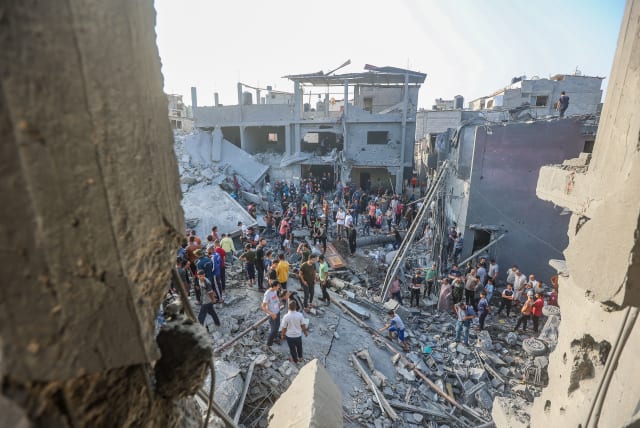Israel's enemies may see the war in Gaza as a road to Jerusalem - analysis

The Gaza Strip was first occupied by Egypt after the partition of British Mandate Palestine into a Jewish and Arab state.
As Israeli troops press deeper into Gaza and the war on Hamas enters its second month, discussions have risen as to what the “day after” will look like in Gaza.
Reports on Sunday indicated that Israel may want more security control in Gaza, and there are concerns about an “exit strategy” once the war goals are reached.
An article at the Carnegie Endowment for International Peace noted that “rather than a ‘day after,’ what seems more likely is a shift from intensive to low-level combat that has no clear resolution.”
Many analysts of the Gaza issue will come at it from their own perspectives, backgrounds, and experiences, which means that in some ways, the parameters of what could or should happen are determined by what each individual thinks would work.
For instance, if one looks at the model of the US war in Iraq or Afghanistan, they are very interested in the exit strategy – because they assume there will indeed be an exit.
If they are looking at the 2017 battle of Mosul, which was won by working “by, with, and through” the Iraqi forces, that raises the question of who the “Iraqis” are in our Gaza scenario; is it the Palestinian Security Forces? And, if so, how would they ever end up back in Gaza?
On the other hand, is there the “you break it, you own it” rule, the warning delivered to George W. Bush on the 2003 invasion of Iraq? Some commentators will inevitably forecast a long insurgency in Gaza if Israel topples Hamas.Is it useful to look at these known unknowns and unknown knowns as if Israel is embarking on a fight that will look like one of America’s wars?
How did we get here in the first place?
A more reasonable question might be: How did we get here in the first place?
The Gaza Strip was first occupied by Egypt after the partition of British Mandate Palestine into a Jewish and Arab state.
Israel took it over in 1967, during which time there were terror threats from within it. In the 1970s, Israel had to confront it. When Hamas emerged in the 1980s, it found popularity in Gaza. By the 1990s it was using that popularity to upend the peace process, and by the early 2000s it had convinced Israel that running Gaza was not worth the price.
Israel withdrew from Gaza in 2005; the result was immediate rocket fire. Hamas exploited the power vacuum to use its stronghold in Gaza to win Palestinian elections and to expel Fatah from Gaza.
This, in turn, convinced Israel that any withdrawal from the West Bank would result in another “Hamastan” there and increase threats to the rest of the country.
For some, Hamas rule in Gaza was always to be used as a weapon to try to draw Israel back into the Strip; Hamas wanted to fight Israel on its own terms and to find a way back into the West Bank. Backers of Hamas in Tehran, Ankara, and Doha wanted this as well, with Qatar hosting Hamas leaders for many years, facilitating their travel around the region.
Doha may think Hamas, like the Taliban, will eventually take over the Palestinian Authority if it is hosted long enough.
There is a saying: ‘If you wait long enough by the river you’ll see the body of your enemy float by.’ It is plausible that some think that if they wait long enough, Hamas will succeed; all they need to do is wait until the ailing, elderly class of PA rulers exits the stage, then Hamas can enter. Sacrificing Gaza may be the price.
As such, the plan of the October 7 attack may have been to cause so many casualties that Israel would have to invade in reaction. Maybe they didn’t think Hamas would kill 1,400 civilians and capture 240 people, maybe a third of that would have been enough, but in the end, the result was the same: Israel had to act, and, in so doing, set everyone on course for a new future, a fundamental break from the past.
Foreign powers try to weigh in
While Israel may be asking what the day after will look like, there are other players, such as Turkey, Iran, Qatar, Russia, and China, who all have plans of their own. Some are lining up behind Hamas, or have already backed it for decades, and see this as an opportunity.
This is reminiscent of the scene in The Godfather when the Corleone family realizes that the Barzini crime family was behind the threats they had faced in the past. Prior to that, they thought they were facing off against a different crime family and the brutal Virgil Sollozzo.
In this story, perhaps Hamas leader Yahya Sinwar is like a Virgil Sollozzo, a bad brutal man who must be eliminated, but what stands behind him is much more complex.
Israel, unlike in the film, may not be ready to try to rid itself of all its enemies at once. The fact the US has sent an unprecedented level of naval units to the region illustrates that the problems in Gaza are only just the beginning.
The dilemma of the “day after” may not be the real question; Gaza may not be where this is leading. In fact, the real “prize” for Doha, Turkey, Iran, and others may be much closer to Jerusalem.
Jerusalem Post Store
`; document.getElementById("linkPremium").innerHTML = cont; var divWithLink = document.getElementById("premium-link"); if (divWithLink !== null && divWithLink !== 'undefined') { divWithLink.style.border = "solid 1px #cb0f3e"; divWithLink.style.textAlign = "center"; divWithLink.style.marginBottom = "15px"; divWithLink.style.marginTop = "15px"; divWithLink.style.width = "100%"; divWithLink.style.backgroundColor = "#122952"; divWithLink.style.color = "#ffffff"; divWithLink.style.lineHeight = "1.5"; } } (function (v, i) { });

